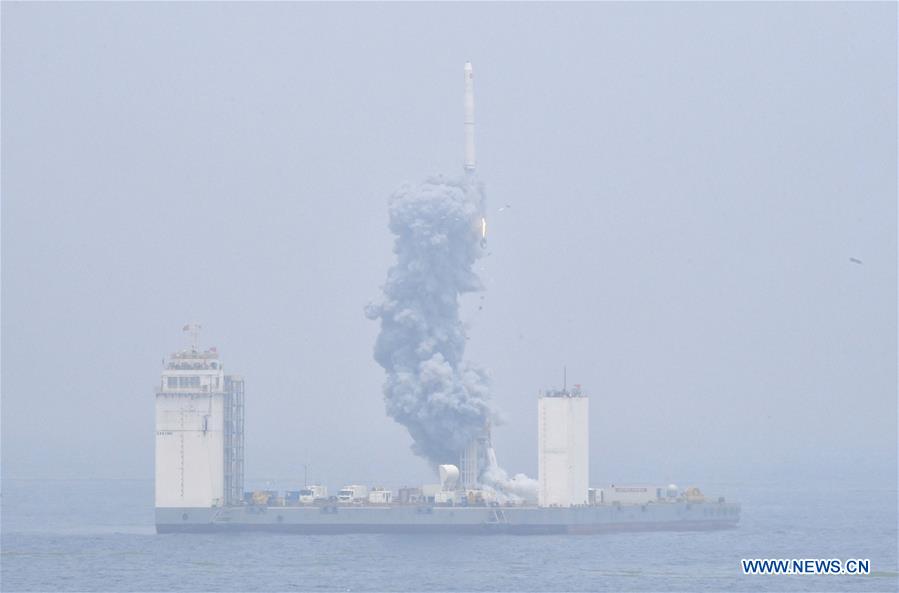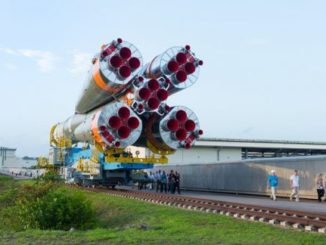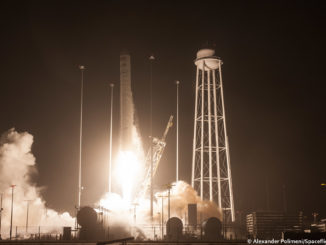EDITOR’S NOTE: Updated June 6 with orbital elements.
A solid-fueled Long March 11 rocket fired out of a container aboard a barge in the Yellow Sea on Wednesday with seven satellites heading into orbit on China’s first space launch from an ocean vessel.
The four-stage Long March 11 booster took off from the converted barge at 0406 GMT (12:06 a.m. EDT; 12:06 p.m. Beijing time) Wednesday, and headed southeast to send its payloads into orbit, soaring over the East China Sea then over the Pacific Ocean after passing between Okinawa and the southernmost of Japan’s main islands.
Chinese officials declared the launch a success, according to state media reports. The 68-foot-tall (20.8-meter) rocket was expected to deliver its seven satellite payloads into orbit several hundred miles above Earth.
The U.S. military’s catalog of space objects registered new satellites attributed to the Long March 11 launch in an orbit roughly 350 miles (565 kilometers) above Earth, at an inclination of 45 degrees to the equator.
Wednesday’s mission was China’s first space launch from an ocean-going mobile platform. The sea-based launch pad allows rockets to reach more types of orbits, including low-altitude orbits that hug the equator, a destination not readily reachable from China’s land-based launch facilities.
The mobile launch platform also gives Chinese space officials more flexibility in selecting a launch site, and ensures spent rocket motors fall into the sea, rather than on land, as they do during launches from China’s inland spaceports.
“On our current land launch sites, the flying area and the debris falling area after the rocket takes off are on land, especially the debris falling area,” said Jin Xin, deputy chief commander for the Long March 11 rocket, in an interview aired on Chinese state television. “As our population density increases, it will inevitably bring some safety risks. However, through seaborne launch, most of the debris falls on the high seas, so we can solve the safety problem first.”
All but one of China’s land-based spaceports are located far from the ocean, meaning rocket components often fall in populated areas. Numerous amateur videos have been posted online showing rocket stages falling back to Earth, including imagery of local residents gathering around the wreckage.
Launching rockets from ocean vessels is not new. Sea Launch, a company founded in 1995 by U.S., Russian and Ukrainian partners, launched 36 missions from 1999 through 2014. Sea Launch focused on launching large geostationary communications satellites on Russian-Ukrainian Zenit 3SL rockets from the equator in the Pacific Ocean south of Hawaii.
But the market dried up for Sea Launch, which was acquired in 2016 by S7 Group, a Russian aviation holding company. The Sea Launch vessels, which include a control ship and a mobile launch pad, remain docked in Long Beach, California, and no firm missions have been announced by S7 Group.
NASA and the Italian Space Agency also conducted nine orbital launches of the solid-fueled Scout rocket from the San Marco platform off the coast of Kenya from 1967 through 1988.
Multiple Chinese support vessels accompanied the Long March 11’s launch platform into the Yellow Sea. During the launch, the barge was located at 34.9 degrees north latitude and 121.19 degrees east longitude, roughly 250 miles (400 kilometers) north of Shanghai.
In an unusual statement before the launch, the China National Space Administration announced the approximate time and location of the Long March 11’s liftoff in a statement early Wednesday.
The Chinese government does not typically officially announce plans for a launch in advance, other than the release of standard airspace warnings for pilots, which outside observers use to estimate parameters such as launch time, launch vehicle, and target orbit. Chinese authorities and state media occasionally do publish launch schedules in advance for human spaceflight missions and lunar probes.

Wednesday’s launch marked the seventh flight of a Long March 11 rocket since it debuted in 2015, and the second Long March 11 flight this year.
Developed by the state-owned China Academy of Launch Vehicle Technology, or CALT, the Long March 11 measures nearly 7 feet (2 meters) in diameter and can haul up to 770 pounds (350 kilograms) of payload to a 435-mile-high (700-kilometer) sun-synchronous orbit. The previous six Long March 11 missions launched from a wheeled mobile transporter at the remote Jiuquan space center in the Gobi Desert of northwestern China.
Several light-class solid-fuel launchers debut in China in recent years, including vehicles developed by commercial companies. Western analysts believe the Chinese launch startups likely acquired their propulsion technology from the Chinese military’s missile programs.
“We have started the process of demonstrating the development of a bigger solid-fueled carrier rocket which has a carrying capacity of 1.5 to two tons and can cover the sun-synchronous orbit at an altitude of 700 kilometers,” said Li Tongyu, chief commander for the Long March 11. “We will need about two years to basically fulfill the development of the carrier rocket.”
The Long March 11 rocket launched Wednesday was designated “WEY” under a sponsorship agreement between the China Academy of Launch Vehicle Technology, China Space Foundation and the WEY line of luxury sports utility vehicles from Great Wall Motors, a Chinese auto manufacturer. The Long March 11 variant used on the sea-based launch was also named the Long March 11H.
Two of the larger satellites on Wednesday’s mission were Bufeng 1A and Bufeng 1B, developed by the China Academy of Space Technology in Beijing, for wind speed measurements over oceans. Data from Bufeng 1A and Bufeng 1B are expected to improve typhoon monitoring and weather forecasts in China, according to the state-run Xinhua news agency.
Another satellite aboard Wednesday’s launch was a Jilin 1 high-resolution Earth-imaging satellite for Chang Guang Satellite Technology Co. Ltd., a commercial spinoff of the Chinese Academy of Sciences.
Chang Guang has launched 13 satellites in the Jilin 1 family since 2015. The Earth observation platforms are designed to collect high-definition video, color pictures, and detailed hyperspectral imagery of Earth, providing information to the Chinese military, civilian agencies and commercial users.
The Long March 11 also launched a pair of small satellites for China Electronics Technology Group Corp., a state-owned developer of electronics, computer, information technology and telecommunications systems. The test satellites will demonstrate Ka-band communications in space, Xinhua reported.
Another smallsat payload launched Wednesday, named Xiaoxiang 1-04, is an Earth-imaging CubeSat for Tianyi Research Institute, a Chinese startup focused on developing microsatellites. The Long March 11 also carried an experimental communications satellite named Tianqi 3, according to Chinese media reports.
With Wednesday’s mission, China has conducted 10 orbital launch attempts so far in 2019. Eight of the Chinese space launch attempts this year have been successful.
Email the author.
Follow Stephen Clark on Twitter: @StephenClark1.



